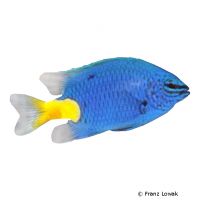Goldtail Demoiselle (Chrysiptera parasema)
| Goldtail Demoiselle Chrysiptera parasema | |
|---|---|
| Name | Goldtail Demoiselle |
| Name Lat. | Chrysiptera parasema |
| Family | Damselfishes |
| Family lat. | Pomacentridae |
| Order | Ovalentarias |
| Order lat. | Ovalentaria inc. sed. |
| Origin | Western Pacific |
| Habitat | Lagoons, coral reefs |
| Diet | Omnivore |
| pH | 8.1-8.4 |
| Hardness | 8-10 °KH |
| Behavior | Peaceful |
| Keeping | Group |
| Reef Compatible | Yes |
| Care Level | Easy |
| Life Span | 3-5 years |
| Protection | No |
| Metric Units | |
| Size | 7 cm |
| Temperature | 24-28 °C |
| Salinity | 33-36 ‰ |
| Aquarium | ~ 250 l |
| US Units | |
| Size | 3" |
| Temperature | 75-82 °F |
| Salinity | 1.020-1.025 sg |
| Aquarium | ~ 65 gal |
Distribution and habitat
The distribution area of Chrysiptera parasema is the Western Pacific, from the Phillipines through New Guinea to the Solomon Islands and the Great Barrier Reef. They live there in protected, coral-rich lagoons and on inner reefs.
Maintenance
They need a well-structured aquarium with a reef structure that allows for territoriality and at the same time offers hiding, resting and covering possibilities, with living stones that act like a biological filter and sufficient swimming space. Only lime-rich, heavy metal-free substrates may be used as substrate
Filters, skimmers and heaters are necessary to ensure water quality, as well as pumps to simulate tides, swells and bottom currents. Lighting must match the species-appropriate day-night rhythm of the animals
| Salinity: 33-36 ‰ | pH value: 8.1-8.4 |
| Carbonate hardness: 8-10 °KH | Nitrate content: 2-8 mg/l |
| phosphate content: 0.01-0.1 mg/l | nitrite content: 0.0-0.05 mg/l |
For salinity, an average value should be aimed for, which may only vary slightly by +/- 0.5 ‰. Ammonia and ammonium must not be measurable. Special attention must be paid to constantly good water quality.
Diet
They feed mainly on zooplankton, but also need plant food. The feed change usually succeeds without problems. The food supply should consist of a commercially available, vitamin-enriched, frozen special food mix for plankton eaters or a combination of algae (e.g. spirulina, kelp) with live and frozen food, such as small mysis, krill, bosmids, cyclops and artemia. In addition, high-quality dry food in flake or granular form with a high vegetable content can be offered, which is usually well accepted. It is recommended to feed small portions several times a day (3-5 times).
Regular and varied feeding promotes health and increases resistance.
Behaviour and compatibility
It is recommended to keep them in a group, one male with several females. To avoid territorial fights, they should be introduced into the aquarium at the same time. Adults can be territorial within the species. However, they are more peaceful among themselves than other Chrysiptera species and can be socialized well with other peaceful fish.
Sex dimorphism
The males are usually larger and slimmer than the females.
Reproduction and breeding
They could already be successfully bred over several generations in the aquarium. The male takes over the brood care and defends vehemently the brood.
Important
It is recommended to keep these reef dwellers together with corals, especially acropores, and not to keep them in a fish-only aquarium.
If different species are kept together, care should be taken to ensure that the fish match each other in terms of water quality and temperature requirements and social behavior, and that the setup meets the needs of all species kept together. Newly introduced fish must be acclimated slowly to the water in the aquarium
Further literature can be found in your pet store.
References
Text: Werner Winter; Image: Franz Lowak
Source: KUITER, DEBELIUS (2007): Atlas der Meeresfische: Die Fische an den Küsten der Weltmeere, Kosmos Verlag; BAENSCH & PATZNER (1998): Meerwasser Atlas Bd. 7, Mergus Verlag; ENGELMANN (2005): Zootierhaltung - Tiere in menschlicher Obhut: Fische, Verlag Harri Deutsch
- Gemäß § 21 Abs. 5 Tierschutzgesetz idgF
